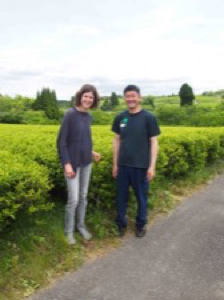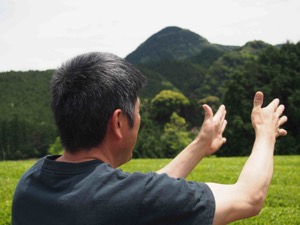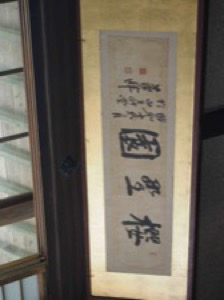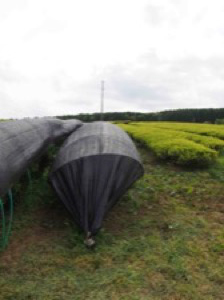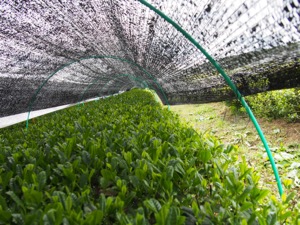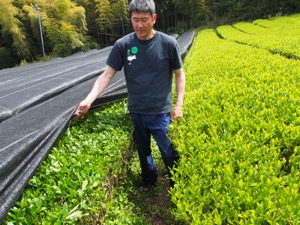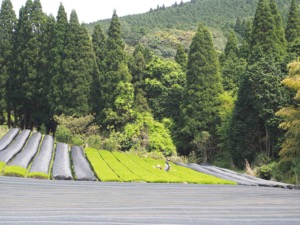Visiting the tea fields of Mr. Matsumoto, the producer of our favourite Sencha
We have to get up very early, as it is a three hours drive to the tea fields of Mr. Matsumoto. I am very nervous, asking myself if my Japanese is sufficient to keep up a conversation with Mr. Matsumoto. On the way I am preparing a vocabulary list on the topics I want to talk about. As our GPS doesn’t recognize his telephone number, we have to ask for the way as we arrive in Minamata. People are very helpful, and finally we make it to the really nice tea plantation area, which is surrounded by mountains and woods. Mr. Matsumoto welcomes us very warm. It is a busy time, especially because tomorrow it is his production day in the fabric, which he is sharing with five other tea producers. He shows us the schedule, which seems well organized. We drive to the first tea field, where he has planted a little plot of Fuji Yutaka and on the other side much more Yabukita, which is the main part of his Sakura-no Sencha. Than we pass by a plot of Zaraishu plants (tea plants grown from seeds). Proudly he explains that this tea plants have been planted by his grandfather and are now 86 years old.
Mr. Matsumoto has 1,5 hectares Zairaishu plants, almost 2 hectares of Yabukita and some Fuji Midori and Benifuki. Asking him for his favourite specie of tea plant, he refers to the Zaraishu plants. As they are grown out of seed, every tea plant is a little bit different. You can see that the colour of the leaves as well as the shape is different. Also they have deeper roots and therefore the plants are getting older. But for Mr. Matsumoto this tea plants are even more special as his ancestor planted them, which bring luck to young Mr. Matsumoto.
On the small curvy roads we drive to a little village, where we have a quick lunch. Proudly Mr. Matsumoto shows us the display of his teas and his logotype of a little tea plant grown out of a seed. Of course I have to show him some pictures of our little tea plants. He seems to like what he sees, which makes us happy. Than we drive to another tea field, where this year for the first time he wants to try to produce Matcha (powdered tea). He already has put the shading construction on top of the plants, which will stay for two weeks. The shading (kabuse) results in smaller, finer and greener leaves with a delicate sweetness.
He is very excited about this new experiment. The difficult part is to dry the leaves in a way that they stay flat, so that in the next step the veins of the leaves can be taken out. As he has not yet an own stone mill for grinding the tea leaves into fine Matcha powder, he will send the tea leaves to a friend in Shizuoka for this last step of production.
The next tea field is situated in a very nice valley surrounded by forest. Half of the Yabukita plants are shaded. Tomorrow here he will pick the leaves for the production of Sakura-no Sencha, which mainly contains a mix of Yabukita unshaded and 50% Yabukita kabuse.
Downhill we see family members of Mr. Matsumoto working. He explains that they clean the tea bushes from the ashes of a nearby volcano, which yesterday had a bigger eruption.
At his house Mr. Matsumoto offers us the first tea, he has produced this year: Shincha Mo. It is 100% Yabukita not shaded. It has a very light green colour and a very delicate Umami. It really tastes like spring. It is the only tea he can offer us from this year, as just tomorrow he starts producing our favourite Sakura-no Sencha. Therefore we taste the Sakura-no Sencha from last year, which he prepares with great care. It has a deeper green colour and we find the more intense seaweed flavour, we like so much.
Than he explains to us, that from his first picking he produces almost just green tea (Shincha and Sencha), from the second picking black tea and Kamairicha (not steamed green tea) and the third picking he uses for Houjicha production (roasted tea). His black tea is a real surprise as it is has a very expressive fruity nose, remembering of plums, and almost no astringency on the palate, but a lot of texture and vibrancy. It is full-bodied, yet smooth. Black Japanese tea is very rare and nowadays also Kamairicha is hard to find. That’s why Mr. Matsumoto started to produce these types of teas, when he took over the tea production from his father. Again and again he proudly refers to his family history in tea making, showing us photographs from the past. It was a wonderful and instructive day. Happily we continue driving further South to Kagoshima.
 Português
Português English
English Español
Español